Category: Hunting Blog
How Weather Affects Antler Size
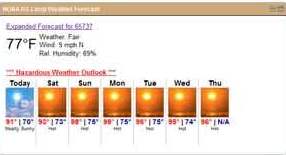 It has been and continues to be very harsh growing conditions at The Proving Grounds. This spring the conditions literally changed from colder and wetter than normal to hotter and drier than normal. That pattern hasn’t changed. Plants don’t grow as much and are less nutritious when they are stressed due to not having enough water. At the Proving Grounds we are experiencing a double whammy with the above normal temperatures. This causes stress in the critters that consume the plants.
It has been and continues to be very harsh growing conditions at The Proving Grounds. This spring the conditions literally changed from colder and wetter than normal to hotter and drier than normal. That pattern hasn’t changed. Plants don’t grow as much and are less nutritious when they are stressed due to not having enough water. At the Proving Grounds we are experiencing a double whammy with the above normal temperatures. This causes stress in the critters that consume the plants.
The results of this stress are shown by less than average antler development, less and lower quality milk production, and therefore smaller and slower developing fawns. The amount of reduction in antler development is related to the severity of stress the plants are experiencing.
There are some practices deer managers can do to reduce the stress caused by lack of rainfall. The most practical is to use soil moisture conservation practices when establishing food plots such as reduced tillage or no-till. The soil at my place is extremely gravely and conserving soil moisture is critical to producing healthy plants and deer. Disking plots is rarely the best practice – and never the best practice at my place because it allows moisture in the soil to rapidly evaporate.
Establishing food plot crops as soon as the conditions (soil temperature and moisture) will allow during the spring is another practice that can offset stress caused by drought. Soil moisture evaporates much faster when the daytime temperature is higher. If the crops have matured enough to shade the ground, there will be much less moisture evaporated when daytime temperatures increase. This is another reason to plant warm season food plot crops as soon as conditions permit during the spring.
Healthy food plots are a great tool to maintain a healthy deer herd. To allow the deer at your Proving Grounds to express most of their potential, start by allowing the forage crops to express their potential.
Growing Deer together,
Grant
Food Plot Competition
It remains very dry at The Proving Grounds. In fact, it’s so dry the native vegetation seems to be going in water conservation mode and as such is not palatable to deer and several other species. This means that food plot crops that are heavily fertilized are probably the most palatable forage available. This usually occurs during late summer after the crops have produced tons of forage. During that time excessive browse is rarely noticed if the number of deer and the quality of the habitat is appropriately balanced.
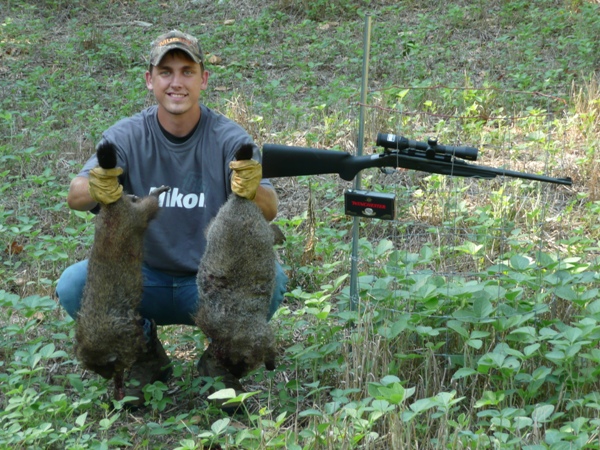 However, when drought conditions occur during the spring and early summer, crops can’t produce normal amounts of forage. Likewise, the native vegetation that usually serves as a buffer while forage crops are becoming established is also unproductive and potentially unpalatable. These conditions can result in food plot crops being damaged by over-browsing. In turn, this results in bucks that don’t express their full antler growth potential and fawns that don’t reach their potential because the quantity and quality of does’ milk production is decreased.
However, when drought conditions occur during the spring and early summer, crops can’t produce normal amounts of forage. Likewise, the native vegetation that usually serves as a buffer while forage crops are becoming established is also unproductive and potentially unpalatable. These conditions can result in food plot crops being damaged by over-browsing. In turn, this results in bucks that don’t express their full antler growth potential and fawns that don’t reach their potential because the quantity and quality of does’ milk production is decreased.
In these circumstances competition for the available quality forage is a concern to hunters and habitat managers. That’s why we have removed several groundhogs near our food plots this summer. They are literally making crop circles in several of my food plots. Groundhogs are good to eat and require skill to harvest. They have a great sense of smell and good vision. In short, they require many of the same skills necessary to harvest a deer. I often hunt them from my deer stands up until August or so. Then I like to reduce disturbance by the food plots and stands as much as possible.
Get your rifle sighted in and grab your safety harness and go groundhog hunting! It’s great practice for deer season while protecting forage in your food plots. Or help a farmer by removing groundhogs from his fields. By providing this service, you may gain access to some great hunting grounds!
Growing Deer together,
Grant
Learning New Whitetail Hunting and Management Techniques
While in college, I was taught about the circle principle. Simply stated, the principle is that our knowledge base is like a circle. As the circumference of a circle increases, the border of the circle gets bigger. Likewise, the more we know, the more we realize we don’t know. I’ve been a practicing wildlife biologist for 20+ years. My firm, Woods and Associates, Inc. was incorporated during 1990. Throughout this time, I’ve worked primarily with white-tailed deer and turkey throughout their ranges. Even with this level of experience and opportunities to learn, I have more questions now than when I started and my desire to learn is probably at an all time high.
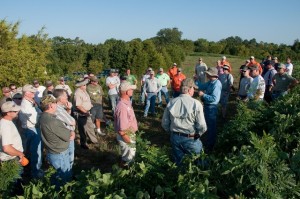 Because I’m now a husband, dad, etc., I have less time I can dedicate to learning, research, etc. That’s why I really enjoy learning from others that share my passion for hunting, wildlife, and habitat management. One of the best ways to meet such folks is at events such as the Land and Wildlife Expo to be held in Nashville, TN during August 12th – 14th. There will be speakers talking about the many aspects of deer management and current topics such as predation. There will also be field demonstrations and the ability to visit directly with manufacturers. This is a great chance to ask wildlife managers and folks from the hunting industry direct questions face to face.
Because I’m now a husband, dad, etc., I have less time I can dedicate to learning, research, etc. That’s why I really enjoy learning from others that share my passion for hunting, wildlife, and habitat management. One of the best ways to meet such folks is at events such as the Land and Wildlife Expo to be held in Nashville, TN during August 12th – 14th. There will be speakers talking about the many aspects of deer management and current topics such as predation. There will also be field demonstrations and the ability to visit directly with manufacturers. This is a great chance to ask wildlife managers and folks from the hunting industry direct questions face to face.
I look forward to learning and hopefully sharing information with fellow hunters and wildlife managers. If you plan to attend, let me know. Several of the GrowingDeer.tv gang are talking about planning a time we can visit about our personal hunting and management plans for this fall. I plan on learning and preparing to be a better hunter this fall. I hope we can visit there.
Growing Deer together,
Grant
Fight Target Panic with Bow Practice
 I’ve shot a bow since early childhood. Even with that level of experience (I’m now 50), I still go through seasons of struggling with shooting accurately. Archery is a very mental sport and no one stays on top of their game every day (or season). In my last blog, bow practice, I discussed the “perfect practice makes perfect” principle as applied to shooting a bow. This week, I’d like to share an archery practice technique called blind bale. It is really a different form of “perfect practice makes perfect.” It is simply practicing with your bow at a target that is only three feet or so down range. In addition, the shooter has his eyes closed throughout the shot. This is done so the shooter can totally concentrate on form and not aiming at a spot.
I’ve shot a bow since early childhood. Even with that level of experience (I’m now 50), I still go through seasons of struggling with shooting accurately. Archery is a very mental sport and no one stays on top of their game every day (or season). In my last blog, bow practice, I discussed the “perfect practice makes perfect” principle as applied to shooting a bow. This week, I’d like to share an archery practice technique called blind bale. It is really a different form of “perfect practice makes perfect.” It is simply practicing with your bow at a target that is only three feet or so down range. In addition, the shooter has his eyes closed throughout the shot. This is done so the shooter can totally concentrate on form and not aiming at a spot.
I started this technique while suffering through a bad case of target panic. When my sight pen would come close to the spot I was aiming, I wouldn’t be able to trigger a release with my eyes open. If you’ve never experienced target panic, you can’t understand, and if you have, you share my grief! A friend of mine, CJ Davis, shared the blind bale technique with me. I thought it sounded silly and continued flinging arrows and flinching. Most shots failed to hit close to where I was aiming.
Out of desperation, I tried the blind bale technique. I shot at a target placed a few feet in front of me for a week. I shot for a week without looking at a spot. I simply shut my eyes and totally focused on my shooting form. During week two, I took 10 shots blind bale and then shot at a pie plate at 10 yards with no markings on it – just a white 9” target. I was amazed at the end of two weeks how well I shot. I was able to group as good as any time during my archery career.
Since them, I usually begin each archery practice session by shooting 10 or so shots using the bind bale technique. At times, I’ve forgotten the lessons I’ve learned and simply began flinging arrows. The size of my groups increase and I remember the huge advantages of reinforcing correct form and starting each practice session with the blind bale technique.
This technique will not benefit everyone as they may have a different problem such as shooting a bow that’s draw weight or length is not appropriate for them. However, if your shooting problems are not the result of equipment that is not tuned or equipment that is mismatched to you, then incorporating the blind bale technique into your practice will probably result in tighter groups at all distances.
Growing Deer together,
Grant
Bow Practice
I really enjoy shooting a bow. However, like most hunters I’m busy with family, work, etc, and my time to simply fling arrows is limited. Therefore I need to make my practice time as effective as possible. Over the years, I’ve learned some lessons that have definitively helped me be a better archer. These include the principle that “perfect practice makes perfect.”
Several years ago I practiced and hunted exclusively with a Black Widow recurve. In fact, the best buck I’ve harvested with a bow was shot with one of my Black Widows! I had shot a recurve on and off since childhood. However, in hindsight, I realized I had simply been flinging arrows. I attended an instinctive shooting clinic hosted by Black Widow and the instructor, Fred Asbell, taught that “perfect practice makes perfect.”
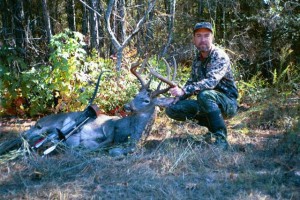 The jest of this principle is that we all learn by memorization – either mental or physical (muscle memory). So, if we simply fling arrows, we may not come to a complete draw, shut our eyes, release improperly, etc. We will be much better archers if we focus on our technique on each shot. If we do that, our muscles will remember the form and it will automatically occur when we don’t have time to go over our mental check list – like when aiming at a mature buck.
The jest of this principle is that we all learn by memorization – either mental or physical (muscle memory). So, if we simply fling arrows, we may not come to a complete draw, shut our eyes, release improperly, etc. We will be much better archers if we focus on our technique on each shot. If we do that, our muscles will remember the form and it will automatically occur when we don’t have time to go over our mental check list – like when aiming at a mature buck.
Since then, I’ve tried to slow down and make each shot count. I’m not a perfect archer, but I’m probably as good as my schedule allows. If you have limited time to shoot your bow, try incorporating the “perfect practice makes perfect” principle into your practice sessions. You will probably fling a few less arrows, but more will be where you are aiming – especially when the target has a lot of bone on its head.
In my next blog, I’ll share another technique that has helped me be a much better shot with a bow. In fact, it helped me resolve some problems I had with target panic.
Growing Deer together,
Grant
Food Plots…Is it Time to Replant?
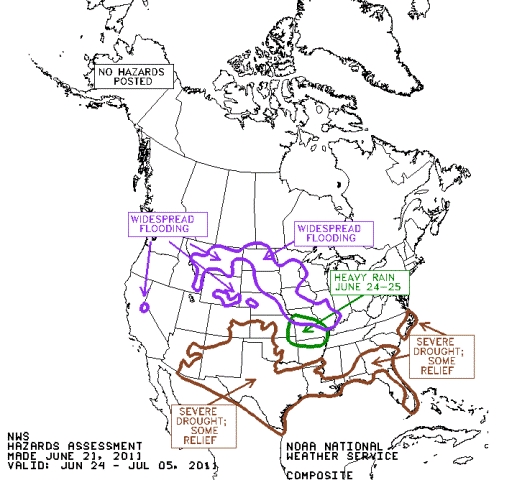 The climate during 2011 in the lower 48 has been a series of extremes. Some areas have experienced severe drought and others have experienced record flooding. Some areas have experienced both. For example, areas along the Mississippi River in Louisiana have received significantly less than normal precipitation during the growing season, but were flooded (as in underwater) because the levies failed or were purposely breeched by the US Corps of Engineers.
The climate during 2011 in the lower 48 has been a series of extremes. Some areas have experienced severe drought and others have experienced record flooding. Some areas have experienced both. For example, areas along the Mississippi River in Louisiana have received significantly less than normal precipitation during the growing season, but were flooded (as in underwater) because the levies failed or were purposely breeched by the US Corps of Engineers.
Some areas that were in a drought are now receiving rain, and some areas that were flooded are now dry enough to plant. Many hunters in these areas have inquired about planting forage crops during late June or even July (hoping that conditions will improve).
There are some forage crops that will respond well to being planted at this time of year if there is the correct amount of soil moisture. Forage soybeans are a perfect example. Research from Iowa State shows that soybeans germinate rapidly when the soil temperature is above 60 degrees and the days until germination actually decrease until the soil temperature at planting depth is over 85 degrees.
Soybeans planted at this time of year may not mature or produce as many pods. However, the forage produced is extremely valuable to deer and other wildlife. In addition, it’s an advantage to establish and maintain a crop so weeds are controlled and the plots will be much easier to prepare for a fall forage crop if the soybeans don’t produce enough pods to justify allowing them to remain throughout the winter.
The map above shows NOAA’s prediction of climate conditions during the next few days. According to their predictions, I may be replanting a few acres of plots at The Proving Grounds that failed due to drought conditions earlier this growing season. Predictions are not 100% accurate. I’ll begin planting when the odds get better or it has already rained. However, I accept food plot failure just as farmers experience failed crops. I attempt to diagnose the cause and replant. Replanting is simply a part of farming. Do you have plots that need to be replanted? Does NOAA’s predictions indicate now is the time for you to replant?
Growing Deer together,
Grant
Locating Deer Blinds
I was in Kentucky the past couple of days working on a property that a client is purchasing. The property has the potential to produce quality deer. However, producing and harvesting are two different tasks. To do both on a sustained basis requires planning and skill. The property has multiple openings that my client will use for food plots. Even though we are currently spraying, fertilizing, and planting these plots, it’s also time to think about hunting them. It’s only mid June, but it’s time to position elevated blinds to optimize the opportunity to observe and harvest white-tailed deer. Properly positioned elevated blinds help conceal a hunter’s movement and reduce scent dispersal.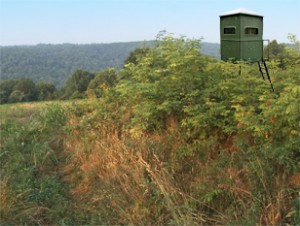
Elevated blinds at some hunting properties I visit are positioned such that it appears the only criterion used to position those blinds was being as close as possible to the plot’s entrance. Although it is possible hunters have experienced success from these blinds, I suspect they would have had more success if the blind had been located based on some simple criteria including;
- Conditions that allow the hunter to approach the stand without being smelled, heard, or seen by deer.
- The likelihood that a hunter can remain undetected by deer while in the stand under specific wind directions, etc.
- The ability of the hunter to leave the stand after the hunt without alerting deer.
These seem like simple criteria to consider when placing an elevated blind. However, locating a blind in a position that increases a hunter’s opportunity to observe and harvest mature bucks on a sustained basis can require a lot of thought. Such stands should be placed during the early to mid summer so deer can become conditioned to the new structure in their living room! Deer, especially mature deer, are often alerted by new fixtures in their territory. Fortunately deer become conditioned to stationary objects within a few weeks unless additional disturbances are associated with the object.
When scouting for a location to place a blind, it’s very important to consider the conditions that will be prevalent when the blind will be used. In many regions the predominate wind direction shifts from a southerly to a northerly direction from the summer months to mid to late fall. If a hunter’s plans include hunting the blind more in the early season compared to the late season, it may be best to place the blind for a southerly wind. Often, the best bet is to place the blind on the eastern side of the area to be hunted. Winds from the east are often rare in many areas of the whitetails’ range.
It’s just as important to consider how hunters will approach the stand without alerting deer. This often means developing a walking trail to the blind other than the road that is normally used to access the plot. This task takes a bit more work, but is well worth the effort as it can substantially increase the opportunity to observe deer from the blind.
Likewise, it’s important to consider where the deer will likely be when each hunt (morning or evening) is concluded so the hunter can leave the blind without alerting deer and conditioning them to associate the blind with danger.
If multiple blinds are to be placed, consider the time of year each will be used and the factors that will impact deer movement at that time of year. These conditions include the harvest of crops, areas that deer bed at that time of year (north slopes during summer, southern slopes during winter conditions), etc.
Each property has unique conditions that should be considered when selecting where to place elevated blinds. Take the time to consider the many aspects that impact the likelihood of observing deer on a repeated basis from an elevated blind. By doing so you can add substantial enjoyment when hunting that location! Now is prime time to do the mental and physical exercises of placing elevated blinds!
Growing Deer together,
Grant
So You Want to be a Wildlife Biologist?
I receive a bunch of emails, Facebook posts, phone calls, etc., asking “What should I do to become a wildlife biologist?” Some of the comments that accompany these notes indicate that some folks believe all that is necessary to become a wildlife biologist is a strong desire to hunt or be outside.
There are probably as many answers to “What should I do to become a wildlife biologist?” as there are wildlife biologists. Here are some of my thoughts on that topic.
- Wildlife biologists usually work more than hunt during hunting season. Opening day is usually spent collecting data from deer that other hunters harvested.
- To be an effective wildlife biologist, it is critical that we can communicate technical information to folks from a wide variety of backgrounds. That means talking and writing to folks with all levels of understanding about wildlife. The need to have good oral and written communication skills is a constant!
- When selecting a field of study or career, take time to determine what you really enjoy. For example, I enjoy eating. However, I don’t enjoy cooking. It’s easy to pick a career based on misguided choices.
One of the best ways to know if you would enjoy and be productive at a career is to give it a test drive. I volunteered to work with a wildlife biologist that managed mule deer habitat on federal land in Nevada. I thought I’d be working with mule deer. However, I identified plant species and distribution in the winter ranges of mule deer during the summer. I rarely saw deer as I worked where mule deer spent the winter while they were typically at a higher elevation during the summer. However, the experience cemented to me that God built me to be a wildlife biologist. It could have just as easily confirmed to me that I’d rather hunt during my vacation days in the fall and forget the ticks and snakes that are present during the summer.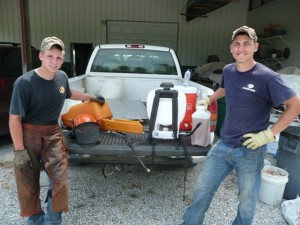
The image to the right is of Hunter and Nathan – two interns helping at The Proving Grounds this summer. Hunter will be a junior at the University of Michigan this fall. He’s trying to decide whether to orient his degree toward wildlife or pre-med. I think Hunter was wise to spend a summer working with a wildlife biologist to see if he truly wants to be working in this field.
It is sad to me that some folks research cars they consider purchasing more than a career choice. You can check out my thoughts on future deer managers and becoming a wildlife biologist to learn more.
Growing Deer together,
Grant
Effect of Delayed Crops on Deer Growth
It has been very wet in much of the Midwest this spring. In fact, many farmers are still planting and/or replanting corn and soybeans due to the wet field conditions. In other parts of the whitetail’s range there is a serious and ongoing drought occurring. In fact, it is a small percentage of the whitetail’s range that has experienced normal precipitation and temperatures during the 2011 spring crop planting season. The quality of the nutrition available is a huge factor in white-tailed deer expressing their full potential. In fact, for whitetails to express their full antler, body and fawn development potential, they require a diet with a sufficient quantity of quality forage year round. Certainly whitetails can and do survive in areas where the quality and/or quantity of forage is less than optimal, however, they do not express their full genetic potential. Due to the typical quality forage (primarily soybeans) available during most of the growing season in the Midwest and grain (corn and soybeans – standing or missed during harvest operations) whitetails usually express more of their potential in areas with ag production compared to areas dominated by timber or pasture. The exception is areas like south Texas where supplemental feed is extremely common. Basically the crops produced in the Midwest are harvested, trucked, and fed at many ranches in south Texas – giving them a very similar diet to deer in the Midwest.
When weather conditions prohibit crops (forage or grain) from being produced during the entire growing season, or the quality of the crops are limited because the soil is too moist or dry for the plants to uptake nutrients, whitetails (and other consumers) will not express as much potential because of reduced dietary quality.
Each week that quality forage is not available reduces a deer’s ability to express its full genetic potential. The lack of ag crops can be buffered by quality native forage. However, weather conditions that reduce the ability of ag crops to be established or produce at their maximum potential also limit native vegetation from expressing its best potential.
Except in controlled environments (like us living in a house versus a tent), tough environmental conditions simply reduce the ability of living organisms to express their full potential. It is much more likely that deer will be able to express more of their potential the following year then to offset a lack of nutrients within the same antler or fawn development season.
From a manager’s prospective, the best plan to limit the amount of variation in deer herd health from year to year is to create a very diverse habitat and maintain a deer herd’s population density well below the amount of food and cover available during tough conditions such as drought, harsh winters, etc. Most deer herds can be fairly productive during years with good growing conditions. However, those weather patterns are rare. By maintaining herds and habitat in a state of readiness for tough conditions, both will be extremely productive when environmental conditions are better than average!
To know what environmental conditions you can expect this growing season use drought prediction maps.
Growing Deer together,
Grant
Cheap Deer Hunting Land
Most hunters I know talk about finding cheap land for deer and turkey hunting! I do also. There is a way that many can gain acreage for literally a few hundred dollars per acre and some sweat equity! It is as simple as controlling noxious, invasive weeds.
Webster’s dictionary defines a weed as: a plant that is not valued where it is growing and is usually of vigorous growth; especially: one that tends to overgrow or choke out more desirable plants. Most hunters can only afford or have access to hunt land that is less than desirable. If weeds are taking up space on your hunting property, then it is much less expensive to kill those weeds and improve the habitat than to purchase additional acres!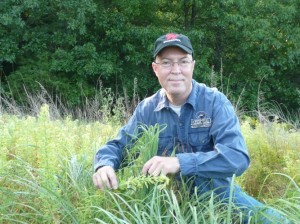
Weeds that are common and very invasive throughout most of the whitetail’s range include:
- Sericea lespedeza
- Johnsongrass
- Honey locust trees
- Knapweed
- Kudzu
There are many more species of invasive weeds that rob literally millions of acres of productivity from wildlife habitat.
The good news is that most of these weeds can be controlled by using a selective herbicide. A selective herbicide is one that only kills specific species. With some research, usually a herbicide that will kill the targeted weeds and not harm the beneficial species can be found. Although this research may seem daunting, I frequently use Crop Data Management Systems free website to research which herbicides to use for specific weeds.
The site can be searched by simply going to the Services and then Labels tabs. Then use simple search for the name of the herbicide to research, or use the advanced search option and search on specific herbicides and the crop you wish to protect.
For example, sericea lespedeza has invaded some of the bedding and native vegetation areas at The Proving Grounds. It doesn’t provide quality forage or cover for wildlife. It is literally decreasing the functional size of my hunting property. Some quick research pointed toward the herbicide PastureGard. However, I wanted specific information to know if PastureGard would control serecia lespedeza and if so, how to apply the herbicide. I searched the CDMS website for the PastureGard label and quickly confirmed it was a good choice to kill serecia lespedeza, how much herbicide to apply, and any personal safety precautions. The image at the top of this blog was taken this morning. I’m thrilled to see the serecia dying and the sparse big bluestem undamaged by the herbicide. I had confidence that would happen after reading the herbicide label.
Controlling weeds is a very important part of wildlife habitat management. Using the correct herbicide, if that’s the best method, saves the manager money and time and returns acres to productive habitat. I’m all about getting more hunting land for not much money and some sweat equity.
Growing Deer together,
Grant





















